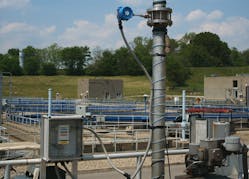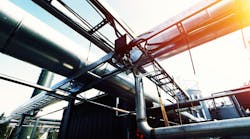Brad Lesko is president and CEO of Fox Thermal Instruments, Inc. He earned his bachelor’s degree in Mechanical Engineering from Cal Poly San Luis Obispo and has more than 15 years experience in engineering product development of mass flow instrumentation. He can be reached at [email protected].
Q: In the United States and abroad, the push for industrial emissions control has been strong through much of the first decade of the 2000s. However, faced with a down economy, less support in Congress, and unemployment lingering just under 10 percent, it seems unlikely that we’ll see a new energy bill mandating emissions control requirements in the United States, at least in the near term. From your perspective, how has industry’s position changed, if at all, given the current economic and political climate in the United States?
A: Generally speaking, constraints in the U.S. political arena will make it difficult to pass carbon reduction legislation in the near term. The energy industry argues that putting caps on emissions or requiring emissions to be reduced will interrupt or decrease their standard modes of production, not to mention the added cost burden of new monitoring equipment, R&D for process improvement strategies, and other system changes or upgrades.
The pulp and paper industry has also opposed emissions reductions rules being put in place by the U.S. Environmental Protection Agency; fighting back with claims that the costs of upgrading equipment and processes may lead them to cut back in other areas, most notably in mill closures and job losses. For this reason, they asked for an extension to the January 2011 deadline, which environmental groups have been pushing through Federal court. The Sierra Club and other environmental groups argue that the cost estimates are overstated and that jobs will actually be created in order to produce, install and operate the new equipment. These arguments seem to have held water, as on December 10, 2010, it was announced that attempts to postpone the ruling’s start date were denied by the federal court and the January 2011 deadline will be upheld.
On another front, the “green” movement has clearly taken hold in the United States, forming a new wave of pressure domestically to reduce energy consumption and CO2 emissions. Consumer scrutiny and concerns related to finite petroleum resources, public health and climate change have resulted in efforts to identify more alternative sources of power and sustainability practices.
As evidenced by the growing number of companies that are making the effort to re-brand themselves, the growing and loyal green consumer segment is an important one, and adjusting to that reality is a priority. In fact, some analysts foresee that green technology will do what telecom did earlier in the decade – specifically, provide new incentives and opportunities for companies to change their business models based on changing circumstances.
Q: With all the talk about the coming of new emissions requirements in the United States, it can be hard to keep track of what is “talk” and what is reality when it comes to emissions requirements. From a regulatory perspective, what are the key federal- and state-level emissions requirements that industry should be monitoring? Please provide a high-level explanation of what these requirements mean for industrial organizations in general.
A: To convince Congress that carbon-reduction legislation is necessary, the U.S. EPA needs irrefutable data. By establishing a baseline measurement, they will seek to prove how emissions are increasing over time and argue the benefits of management and control. Further, despite the political battles being waged over the final regulations, the first steps toward compliance are already being made. Title 30 and Title 40 are focused on data collection and information gathering; specifically which industries are producing the most emissions and where control needs to be instituted down the line.
Meanwhile, states are developing their own initiatives and enacting legislation to regulate emissions. California, for instance, enacted the Global Warming Solutions Act of 2006, which set a Greenhouse Gas (GHG) emissions limit for the year 2020. The California Air Resources Board (CARB) is scheduled to complete major rulemakings for reducing emissions to 1990 levels by January 1, 2011. The GHG rules and market mechanisms adopted by CARB will take effect and be legally enforceable by January 1, 2012.
If the old adage “as California goes, so goes the nation” is to be believed, we can expect to see other states and regional and metropolitan air quality management districts developing their own rules and regulations. One indicator is the number of states that have adopted California’s Clean Car rule. Because the Clean Air Act allows states to follow California’s low emissions vehicle program, many states have already done so. To date, 13 states have adopted the California standards, and several others are considering it. Combined, these states represent almost half the U.S. population.
Q: Are there international trends regarding emissions requirements that you see as potential harbingers of where we may be heading in the United States?
A: The United States is clearly being urged to keep pace with the strides made by other nations where stringent environmental regulations have been in place for years. The principle sources of international environmental pressure are the Kyoto Protocol, U.N. Environmental Program (UNEP), the Intergovernmental Panel on Climate Change, the European Environment Agency, and the Asian Environmental Compliance and Enforcement Network. The signers of the Kyoto Protocol – all industrialized countries except for the United States – are bound to the agreement to reduce their CO2 emissions.
Although there was a failure to make any significant commitments at last year’s U.N. climate summit in Copenhagen, there were some interesting new developments at the climate talks in Cancun last month. After two weeks of discussion, a Green Climate Fund for green development in poor countries was established, and a $100 million-dollar World Bank fund to help countries set up carbon-trading programs was announced.
With these recent developments in mind, the trend that I see unfolding, at least in the immediate future, is one that shows industrialized countries struggling to keep their economies afloat, therefore lacking the capital and political will to institute legislation that will make a significant reduction in CO2 emissions. In the longer term, though, it appears that governments, businesses and individuals, working behind the scenes, are forging ahead with their own projects to cut emissions.
Q: Thermal mass flowmeters are among a number of technologies that figure to see added demand due to an increased focus on industrial emissions control. What role do thermal mass flowmeters play in industrial emissions control applications?
Here a thermal mass flowmeter is used for off-gas monitoring in a wastewater treatment facility. The instrument’s low-flow measurement capability and data-logging software help operators diagnose upset issues to improve process control.
A: Thermal mass flowmeters are an important element of the emissions control process; specifically in the measurement of mass emissions. The thermal flowmeter’s accuracy specification exceeds the requirements defined by Title 40, which requires owners or operators of facilities that emit GHGs to monitor and report annual mass emissions.
The thermal flowmeter’s most important attribute is its ability to directly measure mass flowrate without temperature and pressure compensation. Because it has no moving parts and can be installed via a single insertion point on a pipe or duct, it is easy to install and maintain. The instrument’s broad measurement range also makes it ideal for monitoring very low velocity flowrates, such as those found in vent gas, flare, and fugitive emissions applications.
Most thermal flowmeters also incorporate a totalizer and digital communications for interfacing with emissions management systems and can be used to monitor GHG emissions from industrial, institutional, and commercial boilers.
Q: What are some of the core emissions control/monitoring applications where thermal mass flowmeters can be useful? Are there any applications in particular that you’ve found in your experience to be particularly receptive to thermal mass flow measurement?
A: As mentioned earlier, the thermal flowmeter’s ability to measure very low flowrates is particularly well-suited to vent gas monitoring. A recent study conducted for the Texas Environmental Research Commission (TERC) evaluated emission factors and regional emissions of speciated volatile organic carbons (VOCs) from oil and condensate storage tanks at wellhead and gathering sites in east Texas.
Storage tank emissions were measured by determining vent gas flowrates and sampling the vent gas for chemical composition. Tank batteries having multiple tanks were sampled through common vent gas gathering pipes located at the tops of the tanks. Flowrates were measured using FOX thermal mass flowmeters, and the TERC flow measurement team reported they were very pleased with the instruments’ accuracy and their ability to measure extremely low-velocity flowrates.
Biogas monitoring is another application where thermal flowmeters are frequently specified. Landfills, wastewater and sewage treatment plants, and increasingly, manure digester systems, are measuring and recovering methane – a powerful GHG and also a valuable energy source. A major livestock anaerobic digester manufacturer uses FOX thermal flowmeters to measure the methane that is captured by the biodigester and then used to fuel boilers and generators associated with their applications.
The company originally used traditional DP metering technology, but found that method unsuitable for the varying flowrates and corrosive gases they encounter. Variations in flowrate caused by seasonal climate changes, and the gas spikes that occur after feeding the digester are not a challenge for thermal flowmeters.
Thermal flowmeters are also used to monitor flare gas from digesters. Measuring all combusted methane, including the excess gas that is flared, is an important element of the certification process needed to document, verify, register and monetize reductions in GHG emissions.
Q: In addition to emissions monitoring, thermal mass flowmeters have been touted for their abilities in the areas of improved process control and energy accounting. What roles do thermal mass flowmeters play in these aspects of industrial systems?
A: Plant managers seeking to improve combustion performance and product quality must balance fuel and energy-saving measures with emissions reduction priorities. One of the most effective techniques is a precise control strategy, based on mass flow measurement of fuel and air flow. Accurate, repeatable measurement of air and natural gas, at low and varying flowrates, is a critical variable in combustion control.
Unlike orifice plates, turbine meters, and other volumetric flow devices, the thermal mass flowmeter is virtually immune to changes in temperature and pressure and is capable of providing a more accurate measurement of mass flow rate. Thermal flowmeters are frequently installed in fuel gas and air feed lines to optimize combustion and facilitate proactive emissions control.
Rising energy prices have also made daily accounting of natural gas usage a priority for large industrial facilities with multiple processes and/or buildings. Fuel gas flowmeters are used to analyze demand, improve operating efficiency, reduce waste, and adjust for peak usage. Here, the thermal flowmeter also helps plant managers provide accurate usage reports for environmental compliance, and compare measured usage to billing reports from gas providers.
Insertion-type thermal flowmeters are easily mounted in suitable installation points throughout the facility, and provide an accurate, repeatable reading of natural gas consumption by plant, process, or tenant. In constrained areas, inline meters reduce the traditional requirements for straight, unobstructed upstream piping and simplify installation.
Typical applications include:
• Sub-metering by department or process helps manufacturers assess inefficiencies, assign costs, and implement conservation measures.
• University campuses and industrial parks use totalizing flowmeters to allocate fuel costs to various buildings and/or tenants.
• Natural gas check meters are often used to document usage, negotiate rates, and resolve billing disputes.
• Thermal flowmeters may be used to monitor and bill for fuel consumption on skid-mounted generators and compressors.
Q: Going forward, how do you see thermal mass flowmeters evolving to better support emissions control/monitoring applications? How will the thermal mass flowmeters of tomorrow be more effective than the thermal mass meters of today when it comes to emissions control/monitoring applications?
A: Emerging emissions monitoring regulations will provide the next big lift in the thermal flowmeter business, as pointed out by Jesse Yoder in Flow Control magazine in his recent article “A Market Prime for Boom” (March 2009). He said that “despite a global economic slump, thermal flowmeters are suddenly emerging into the spotlight,” based on their demonstrated suitability for emissions monitoring.
Today we are working closely with our OEM and end-user customers to provide reliable, cost-effective solutions to existing and emerging emissions monitoring applications in a wide range of industries. I anticipate that the most important development in next-generation thermal flowmeters will be communications features that allow meters to be networked to provide real-time data – not only for emissions monitoring, but also for process improvement to help manufacturers enhance their carbon competitiveness. Improved accuracy and advanced instrument diagnostics are also areas that thermal flowmeter designers and manufacturers will focus on.
It is an exciting time for our industry and we look forward to partnering with our customers around the world – helping them achieve and maintain compliance with environmental standards, conserve energy, and optimize their processes and operations.




